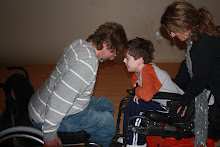We began with chanting, "Om Shante" translating to peace and calling upon the feeling of peace within. The positive effect of chanting:
• 0pens the throat which is the center of communicating and truth
• Improves breath function and use of abdominal muscles in order to sustain long held sounds
• Activates the parasympathetic response with soft pitch sounding
• Stimulates the sympathetic nervous system response to produce energy
• Improves hand eye coordination when adding hand gestures to the chant
Next we focused on Pranayama (Sanskrit word for breath). I taught them Simhasana (Lions Breath). The positive effects of this practice include:
• Relieving tension in the jaw, and face
• Helps to change to moot, encourages laughter
• Proper inhale and exhale ratios to bring balance
Then we launched into some mild chair poses and some asanas (name for physical poses) for strength:
• Virabradasana II (Warrior II)- encourages proper body mechanics with awareness ( knee over ankle, broad through upper back and chest, tailbone down, belly in). Holding this pose for several breaths encourages strength in quadriceps, abdominals, and upper arms and shoulders.
• Tadasana (mountain pose)- sometimes translated to equal standing, allowing all the muscles from the bottoms of the feet to the top of the head to work in combination and coordination with each other translating to a feeling of stability and strength while upright. Combining this with Anjuli Mudra (prayer hands) allows the student to connect with their own divinity through the posture of reverence.
Every yoga class ends in a period of relaxation in which the body is allowed to rest in stillness in order to allow the physical body to take in the effects of the practice at a cellular level.
• Savasana (Corpse Pose)- in complete physical stillness, I was able to observe a complete release as I went around to each student, laying hands on their shoulders to encourage grounding, bodies softened.
• Dhyana (Meditation)- yoga was originally developed to get the physical body to a point where it was appeased with movement so that it could rest in the stillness of meditation. Through the focus on the breath moving in and out through the nostrils I led the students through a guided meditation. We focused on the heart, visualizing a green light illuminating the heart space and growing from there. In the light of the heart space a feeling of compassion, kindness and love grows spreading to the entire body and beyond allowing the student to release pent up emotions of loss, grief, sadness for a life lost through tragic circumstances. A growing sense of compassion and kindness toward the self that is in the present moment of this experience develops strengthening and creating new brain pathways.
What I left with as a teacher and facilitator of the student experience was a sense of awe for the level of concentration of these students, whose lives had been wrangled away from them through tragic circumstances. Their willingness, even those that protested verbally or whose physical bodies seemed to protest so impressed me. One student smiled the entire time, another cursed often, but the body kept attempting the practice and single focused attention was paid to the practice. Following our final blessing: “Om Shante, Shante, Shante,(peace, peace, perfect peace)… Namaste” (traditional closing to yoga practice which translates to “the divine in me bows to the divine in you”) a student approached me to say, “Thank you for reminding me of my former self… I used to be an athlete and this practice reminded me of whom I once was… Thank you!” Tears welled in my eyes to have been able to bring this man such a gift, a gift to which I offer credit to a benevolent energy (call it God, Higher Power or universal kindness, the name is irrelevant to the power of the energy) which shows up in yoga practice when the student is open to experiencing it. This is the true power of yoga, that which cannot be explained, but must be experienced.
Lokah Samastah Sukhino Bhavantu

